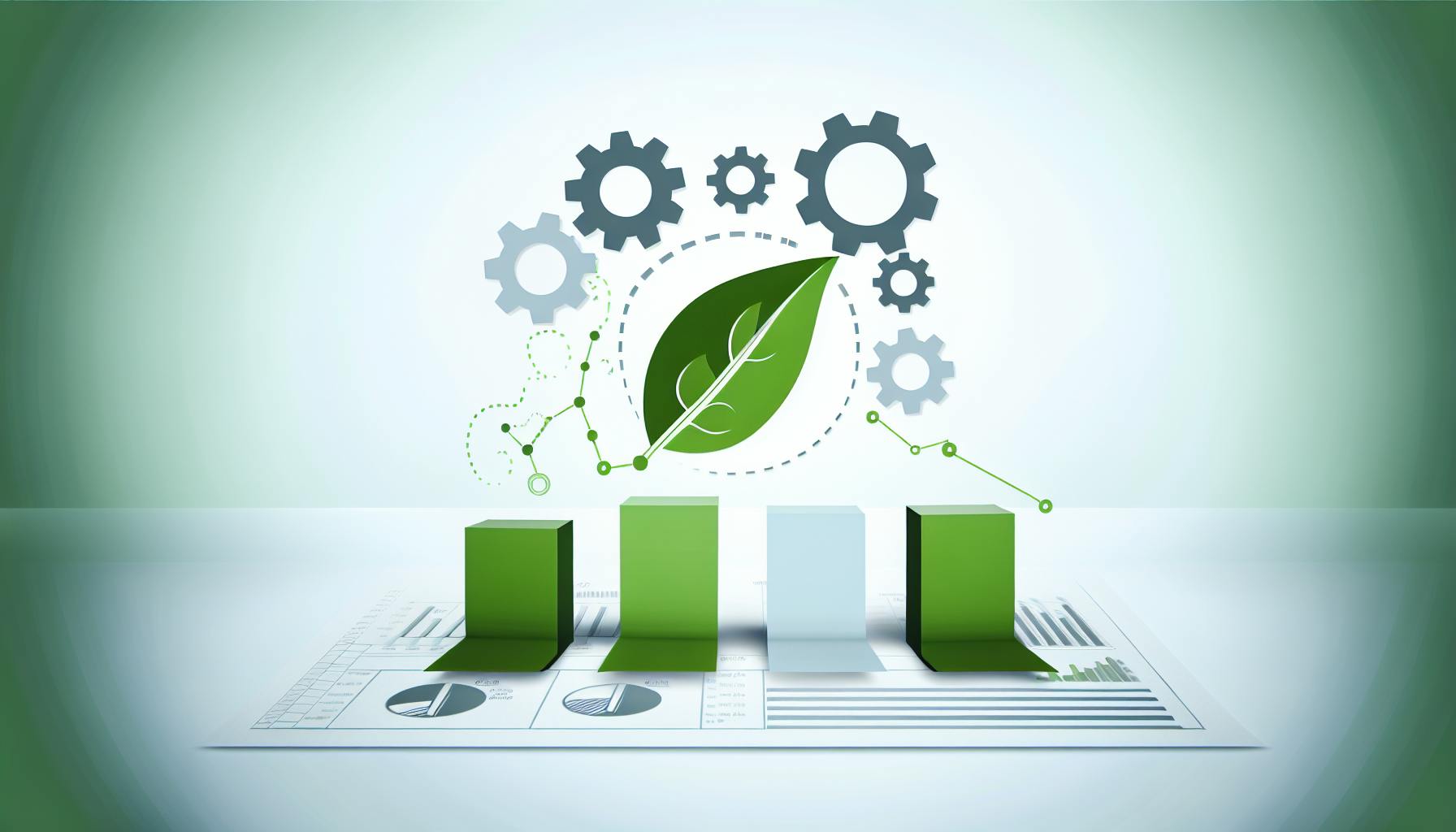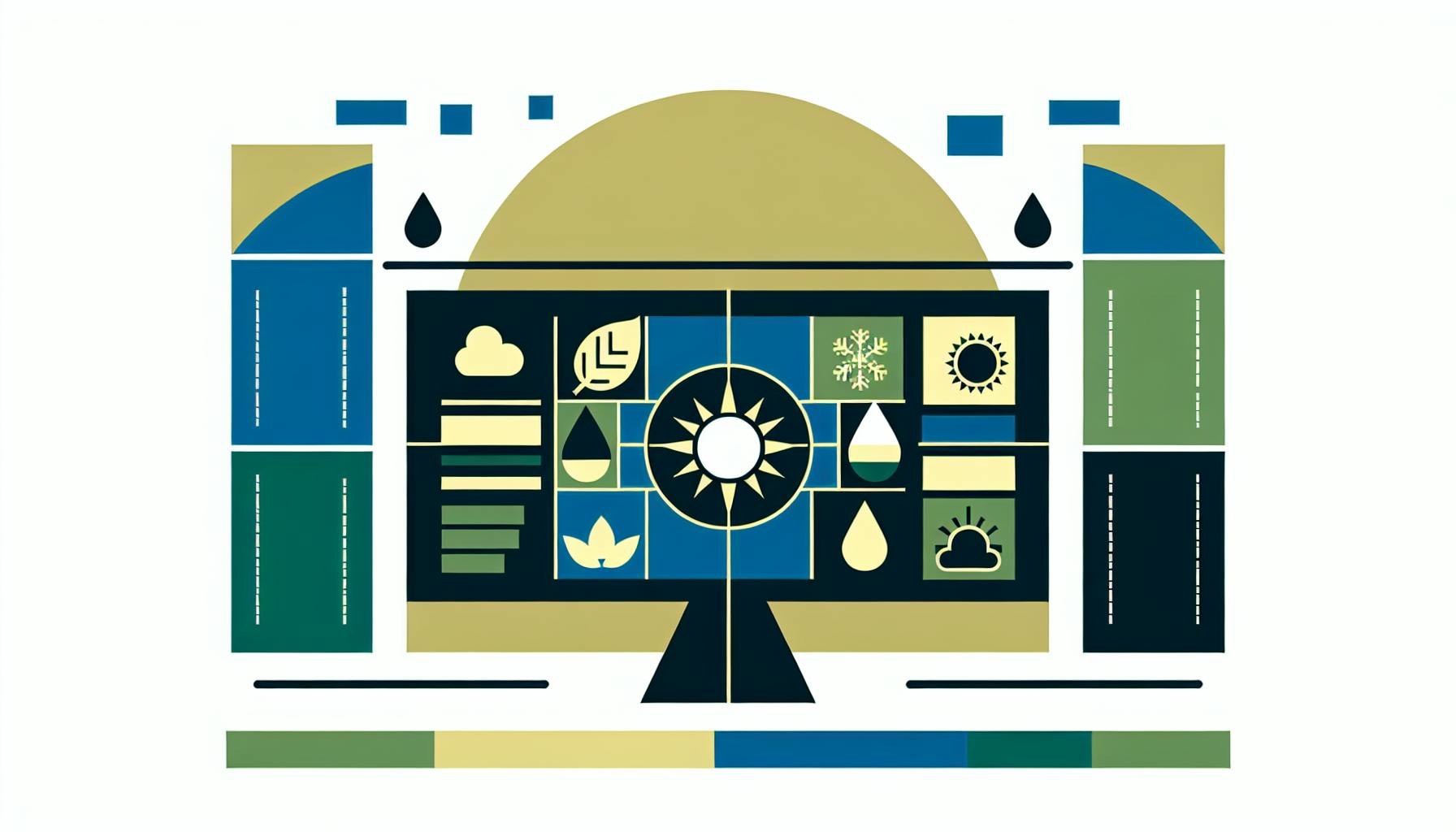Most organizations would agree that effectively managing and reducing carbon emissions is an important part of climate change mitigation.
Using carbon offset software can help streamline the process of calculating, reducing, and offsetting carbon emissions from business operations and travel.
In this article, we will explain what carbon offset software is, its key capabilities, criteria for selection, and how it can be implemented as part of a comprehensive corporate sustainability strategy aimed at achieving carbon neutrality.
Introduction to Carbon Offset Software
Carbon offset software refers to tools and platforms that help organizations calculate, reduce, and offset their carbon emissions. As companies aim to meet net zero targets and improve sustainability, these solutions are becoming increasingly valuable.
Defining Carbon Offset Software
Carbon offset software provides capabilities to:
- Measure an organization's carbon footprint across scopes 1, 2, and 3
- Model and forecast emissions under different scenarios
- Identify opportunities to reduce emissions through operational changes
- Offset remaining unavoidable emissions by supporting certified climate projects
- Track progress toward sustainability goals and compliance reporting
By leveraging carbon offset software, companies can better understand, manage, and mitigate their climate impact.
The Importance of Carbon Offsetting in Climate Change Mitigation
With the pressing need to limit global temperature rise, carbon offsetting has an important role to play. When done right, it channels funding to emissions-reduction projects that may not otherwise be financially viable. This directly contributes to climate change mitigation.
International standards like Gold Standard and Verified Carbon Standard ensure the quality and impact of offsets. As more businesses turn to carbon offset software and credibly offset their emissions, more emissions get mitigated economy-wide.
Benefits of Using Carbon Offset Software in Corporate Sustainability Strategies
Integrating carbon offset software into sustainability strategies allows companies to:
- Identify the largest sources of emissions across operations
- Uncover cost and emissions saving opportunities
- Benchmark against industry peers on sustainability performance
- Meet emerging disclosure requirements and standards
- Communicate climate commitments and progress to stakeholders
By providing data-driven insights and enabling credible climate action, carbon offset software is becoming a core tool for businesses on the path to net zero.
Which carbon offset program is best?
When choosing a carbon offset program, there are several key factors to consider:
Reliability and Transparency
It's important to select a program that clearly explains where your money goes and what impact it has. The best carbon offset programs provide transparency through public reports on the emissions reduction projects they support. They also utilize third-party verification to ensure the projects genuinely reduce emissions. Programs like Native Energy and 3Degrees are leading options in this regard.
Types of Projects Supported
There is a range of project types like renewable energy, forest conservation, or community-based programs. Consider what you care most about supporting. Native Energy, for example, focuses on new clean energy projects to displace fossil fuels.
Offset Calculation Methodology
Programs may use different carbon accounting methods, which can significantly impact the number of tons offset for the same donation amount. Selecting an offset provider that uses clear, conservative calculations inspires confidence that your purchase makes a real impact.
Cost Per Ton of CO2
While some appear cheaper, very low prices (under $5-10 per ton) likely indicate lower quality offsets. Higher prices often support more impactful projects. Consider offset cost relative to project quality and emissions reductions.
Types of Purchases Supported
Some programs like Carbon Checkout allow micro-donations during online purchases. Others like myclimate have offset packages tailored to flight emissions. Assess which purchase types matter most for your needs.
Taking these factors into account, Native Energy, 3Degrees, and Sustainable Travel International rise to the top for reliability, transparency, and support of high-quality, additive clean energy projects. Evaluate your priorities to determine the best carbon offset program for your situation.
What is the carbon offset program?
Carbon offsets allow individuals and companies to compensate for their carbon emissions by funding projects that reduce greenhouse gases. These projects often support renewable energy, forest conservation, or other sustainability efforts.
When you purchase a carbon offset, you are paying someone else to reduce their emissions on your behalf. This funds projects like building solar and wind farms, distributing clean cookstoves in developing nations, and other initiatives aimed at taking CO2 out of the atmosphere.
Each offset is equivalent to one metric ton of carbon dioxide prevented from entering the atmosphere. Offsets are verified by independent third parties to ensure the emissions reductions are real and wouldn't have happened without the funding.
Using carbon offsets can be an interim solution on the path towards a net zero carbon future. While offsets don't eliminate the need to also reduce your own emissions, they allow immediate climate action by supporting impactful sustainability projects around the world.
What is carbon management software?
Carbon management software refers to technology solutions designed to help organizations measure, report, reduce, and offset their carbon emissions. This type of software provides the tools and insights needed to develop comprehensive carbon management strategies aligned with climate goals.
At a high level, carbon accounting software enables companies to:
- Calculate their overall carbon footprint across scopes 1, 2, and 3 emissions
- Identify the largest sources of emissions within their operations and supply chain
- Set carbon reduction targets and create detailed plans to decrease emissions over time
- Track progress against goals and generate the reports needed for compliance and disclosure initiatives
- Access carbon credit markets to offset remaining emissions and work towards net-zero
Key capabilities provided by leading carbon management platforms include:
- Data collection - Collect energy, fuel, materials, logistics, and other operational data needed to model emissions
- Calculation engines - Convert the data into CO2e using verified emissions factors and standards
- Visualization - Present emissions data through interactive dashboards and graphs
- Target setting - Establish science-based targets aligned with 1.5°C pathways
- Strategizing - Map out detailed carbon reduction plans across facilities, transport, procurement, etc.
- Offsetting - Seamlessly connect to top carbon credit platforms to neutralize unavoidable emissions
- Reporting - Automate report generation for carbon disclosures like CDP, GRI, and SBTi
By leveraging purpose-built software, companies can streamline the entire carbon accounting and reporting process. This enables sustainability teams to focus their efforts on interpreting the data, identifying hotspots, and driving strategic emissions reductions across the business.
Is Microsoft carbon free?
No, Microsoft is not yet carbon free, but they have made a commitment to become carbon negative by 2030. Here is a brief overview of Microsoft's carbon reduction strategy:
What is Microsoft's commitment?
Microsoft has pledged to be carbon negative by 2030, meaning they will remove more carbon from the atmosphere than they emit each year. By 2050, they aim to have removed from the atmosphere all the carbon the company has emitted since its founding in 1975.
How will they achieve this?
Microsoft plans to reduce their carbon emissions by:
- Increasing energy efficiency and shifting to 100% renewable energy sources for their data centers and campus operations
- Electrifying their global campus vehicle fleet
- Pursuing negative emission technologies like carbon capture and storage
They will also invest in carbon removal projects like reforestation to offset remaining emissions they cannot yet eliminate from their operations and supply chain.
What progress have they made?
As of 2020, Microsoft has been carbon neutral meaning they purchase renewable energy and carbon offsets to cover their total emissions. 60% of their electricity consumption now comes from renewable sources.
While not yet carbon free, Microsoft's environmental commitment is one of the most ambitious in the tech sector. Their progress demonstrates serious efforts to reduce their climate impact.
sbb-itb-c2a0016
Understanding the Functionality of Carbon Offset Software
Carbon offset software provides companies with tools to measure, reduce, and offset their carbon emissions on the path towards net zero. This enables organizations to calculate their footprint, identify emission reduction opportunities, invest in certified climate projects, and track sustainability performance.
Calculating Emissions with a Carbon Footprint Calculator
Carbon footprint calculators quantify a company's total greenhouse gas emissions across all scopes using verified emissions factors and activity data. This allows businesses to establish a baseline and set science-based targets. Calculators account for direct emissions from owned sources (Scope 1), indirect emissions from purchased electricity and heat (Scope 2), and other indirect emissions across the value chain (Scope 3). Robust data collection and analysis ensures an accurate picture of a company's climate impact.
Identifying Reduction Opportunities through Data Analytics
Sophisticated data analytics within carbon management platforms can detect "hot spots" for potential emission reductions aligned with 1.5°C pathways. This facilitates targeted mitigation strategies across operations, supply chain, and products. Analytics-driven insights also allow companies to model different decarbonization scenarios and optimize investment decisions. Ongoing tracking of emissions data enables businesses to monitor performance improvements over time.
Offsetting Remaining Emissions with Market and Non-Market Mechanisms
After reducing emissions in line with science and equity, high-quality carbon offsets enable companies to counterbalance residual outputs. Offsets fund projects that avoid or remove emissions outside of a company's value chain, like renewable energy or reforestation. Credible standards like Gold Standard and Verra provide assurance that offsets represent real, additional, and permanent emission reductions. Robust carbon offset software simplifies the offset procurement process and ensures portfolio transparency.
Ensuring Transparency in Tracking and Reporting
Software solutions equip businesses with customized climate dashboards to visualize progress towards interim and long-term sustainability targets. This facilitates robust tracking and powers automated reporting aligned with leading disclosure frameworks like CDP, GRI, and TCFD. Easy report generation and data exports assist companies in transparently communicating their decarbonization journey to both internal and external stakeholders.
Criteria for Selecting Carbon Offset Software
Comprehensiveness of Scopes and Boundaries Covered
When evaluating carbon offset software, it is critical to assess the comprehensiveness of emissions scopes and organizational boundaries covered. Most providers allow you to account for Scope 1 and 2 emissions from owned or controlled sources. However, to obtain a complete carbon footprint, Scope 3 emissions from value chain activities should also be measured.
The software should enable defining both operational and financial control boundaries that align with GHG Protocol methodologies. This allows inclusion of emissions from subsidiaries, joint ventures, outsourced operations, investments, and across the full product lifecycle. Having flexibility in boundary setting is key for consistency across reporting periods as your business evolves.
Ideally, the software should accommodate current needs and future expansion of inventory scopes and boundaries as measurement capabilities progress.
Adherence to Offset Standards and Certifications
It is essential to verify that the carbon offset projects offered by the software comply with stringent standards and retire certificates on the company's behalf. Internationally recognized standards include:
- United Nations Carbon Offset Platform
- Verified Carbon Standard (VCS)
- The Gold Standard
Such standards provide credibility through third-party validation, monitoring, transparent reporting and registry systems.
The software should also enable certification under climate leadership programs like Climate Neutral Now once emissions are fully offset. Having a vetting process for offset quality gives assurance that investments authentically deliver emissions reductions.
Integration Capabilities with Existing Systems and Customization
When possible, leverage software that integrates with your existing data sources and workflows to streamline data collection and analysis. API connections with key business systems like ERPs, CRMs, and utility trackers minimize manual inputs for greater accuracy.
You should also assess the ability to customize carbon calculations and reporting to your business model and sustainability objectives. The software should accommodate setting reduction targets, forecasting future emissions, and scenario modeling to inform strategic decisions.
Flexibility to meet current and evolving needs makes adoption seamless across the enterprise.
Reporting and Disclosure Capabilities for Net Zero Recognition and Accountability
To benchmark progress and meet stakeholder expectations, the software should enable automated report generation per major disclosure frameworks. These include CDP, GRI, TCFD, SBTi and others that investors and customers are requesting.
The system should also issue credible proof of carbon neutrality for conformance with net zero standards like the United Nations Net Zero Recognition and Accountability Framework. Such recognized designations signal your climate leadership to the marketplace.
Ultimately, leveraging carbon offset software for robust measurement, reductions and offsetting is key to substantiating net zero claims and driving accountability.
Implementing Carbon Offset Software for Sustainable Travel and Operations
Securing Leadership Buy-In for Climate Action
Gaining executive support is key for successfully rolling out a carbon offset software program. Highlight the business benefits, including cost savings, risk mitigation, investor appeal, and improved brand reputation. Provide case studies of peer companies who have benefited. Offer pilot programs to demonstrate potential ROI. With C-suite endorsement, adoption across the organization will be smoother.
Building a Cross-Functional Team for Climate Technology Integration
Assemble an implementation team with representatives from sustainability, finance, IT, operations, HR and other groups. Outline clear goals, responsibilities and timelines. IT will connect data flows and integrate software. Sustainability will conduct trainings and drive participation. Finance tracks spending and savings. HR communicates employee benefits. Operations adapts processes. With alignment across departments, the technology can be embedded organization-wide.
Conducting Initial Assessments for Emission Reduction
Before implementing carbon reduction initiatives, conduct a baseline emissions assessment. The software can automatically pull data to calculate your carbon footprint across facilities, transportation and supply chain. Identify the largest sources of emissions to focus reduction efforts for maximal impact. Regularly benchmark against this baseline to quantify progress over time as new sustainable practices take effect.
Seamless Integration with Business Systems
To ease data collection and analysis, integrate the carbon offset software with your existing platforms like ERP, accounting, CRM and HRIS systems. IT can build automated data syncing from source systems to eliminate manual inputs. As business data gets updated in core platforms, the sustainability software will stay current. This saves time while enabling real-time carbon accounting and actionable insights.
Educational Training for Employees on Carbon Mitigation
Conduct internal training sessions to educate employees on leveraging the carbon offset software to advance company sustainability goals. Show how their everyday decisions and actions translate to carbon emissions and environmental impact. Offer guidance on interpreting analytics to inform green initiatives. Inspire engagement through incentives and gamification. An educated, motivated workforce is vital for meeting ambitious climate targets.
Achieving Carbon Neutrality with Offsets and Renewable Energy Projects
Determining an Offset Budget for Climate Neutrality
To achieve carbon neutrality, organizations must first calculate their total greenhouse gas (GHG) emissions that remain after internal reductions. This residual emissions figure represents the amount of carbon offsets a company needs to procure. Carbon offset software provides built-in emissions calculators to arrive at this number based on energy usage, travel, purchased goods and services, and more. Companies should allocate an offset budget that matches their residual emissions. For small businesses, this may be just a few tonnes per year. Larger corporations likely need to offset hundreds or thousands of tonnes annually. Defining the right budget ensures organizations completely neutralize their climate impact.
Selecting Certified Projects in Renewable Energy and Beyond
Once an offset budget is set, companies can use carbon offset software to browse and select certified emissions reduction projects to support. These projects go through a strict verification process to ensure they provide real, additional, and permanent emissions savings that wouldn't have occurred otherwise. High quality projects tend to focus on renewable energy, especially solar and wind. Reforestation initiatives that plant trees are also common. Other project types include clean cookstoves in developing countries, methane capture on farms or landfills, and more. Companies should vet each project carefully and invest only in those aligned with corporate values and climate commitments.
Managing and Retiring Offsets to Achieve Transparency
As companies procure offsets against their budget, carbon offset software enables them to directly fund projects and retire the resulting emissions savings on their behalf. Each tonne of CO2e mitigated is assigned a unique credit retired in the company's name via a public-facing registry. This creates complete transparency, allowing stakeholders to see the volume and types of projects organizations supported to reach net-zero emissions. The software makes it simple for companies to manage procurement and retirement of offsets to attain third-party validation of their carbon neutral status.
Communicating Climate Impact and Corporate Responsibility
Offset software also assists with climate reporting. Companies can access user-friendly analytics on emissions sources, reductions, offsets purchased, projects supported, and more. These verified climate metrics can be included in CSR reports and sustainability disclosures to demonstrate progress towards carbon neutrality goals. For many organizations, the ability to publicly report the real-world impact their offset investments made possible is just as valuable as achieving net-zero status. It communicates their corporate responsibility commitment in an authentic, transparent way.
The Future of Carbon Accounting and Innovation
As the impacts of climate change intensify and global momentum builds around net zero commitments, innovations in carbon accounting and offsetting will be critical for enabling corporate climate action. This section explores some of the key developments on the horizon.
Advancing Scope 3 Emissions Management for Sectoral Engagement
As more companies pledge to reduce value chain (Scope 3) emissions, carbon accounting systems will need to facilitate supplier engagement and track indirect emissions with greater granularity. Emerging software solutions aim to streamline scope 3 inventories across entire sectors, enabling transparency through automated data collection and verification. These innovations can incentivize decarbonization efforts across complex global supply chains.
Exploring Blockchain for Enhanced Carbon Accounting Transparency
Blockchain technology shows significant potential for providing transparent and immutable tracking of carbon credits and offsets across organizations. Future carbon accounting platforms may incorporate blockchain to allow companies to seamlessly purchase credits, while guaranteeing their authenticity and preventing double-counting. This could greatly enhance trust and accountability in carbon markets.
Leveraging AI for Climate Action, Finance, and Adaptation
AI tools can optimize GHG inventories, automatically identify hotspots for reductions, and suggest abatement pathways aligned with science-based targets. Looking ahead, AI could also match mitigation and adaptation projects with financing by analyzing project data and predicting ROI. By enhancing analysis capabilities and connecting stakeholders, AI can accelerate climate action across sectors.


